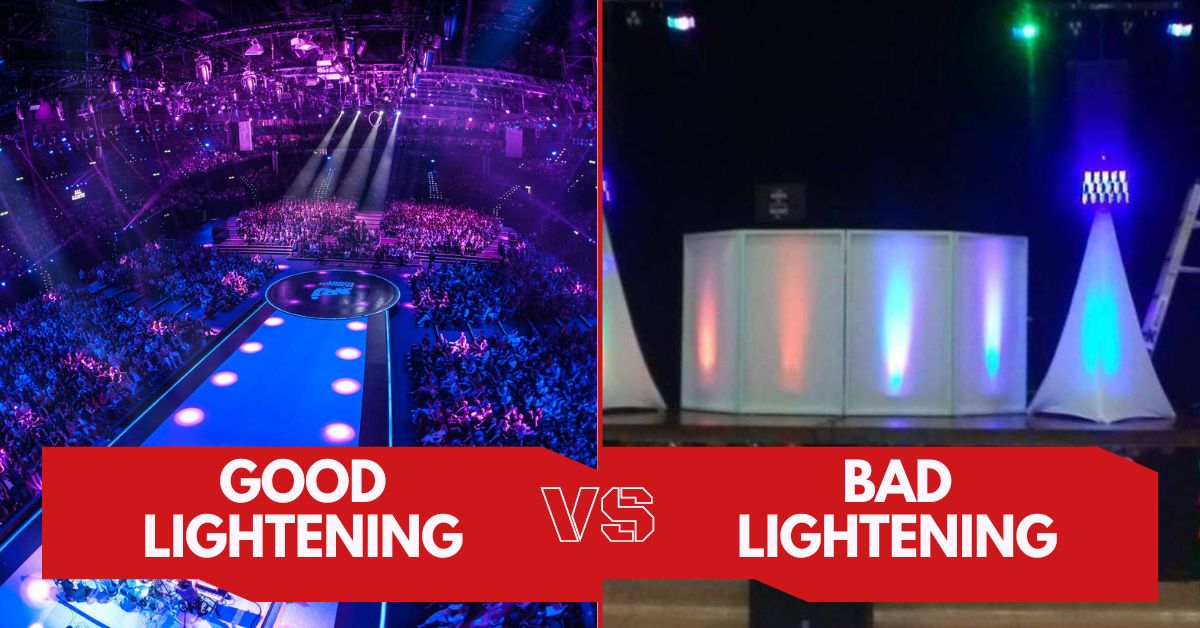Despite being a necessary component of our everyday existence, lighting is frequently disregarded or taken for granted. The stark difference between good lighting vs bad lighting becomes apparent when we consider its profound impact on our well-being and surroundings. Good lighting transcends mere functionality; it has the power to enhance our mood, increase productivity, and improve the overall aesthetic of a space.
Amidst the spectrum of lighting scenarios, an example of where the consequences of bad lighting are particularly evident is stage lighting design. The artistry of stage lighting becomes important in the realm of performances, whether it be theater, concerts, or events. We may choose the best lighting for our homes and workplaces by being aware of the significance of lighting and how it affects our day-to-day activities.
In this blog, we will delve into the differences between good and bad lighting and explore the various factors that contribute to each.
The Impact of Lighting on Well-being
Good Lighting
Wanna know what is good lighting? Here are some aspects of this lighting:
Mood Enhancement
Adequate lighting has the power to enhance our mood and create a positive atmosphere. Serotonin levels are known to be raised by natural light in particular, which promotes emotions of happiness and wellbeing.
Productivity Boost
Well-lit spaces are conducive to increased productivity and focus. Good lighting helps reduce eye strain and fatigue, allowing individuals to work efficiently for longer periods. No matter if you are at home or at your working space, you must have this productivity boost!
Aesthetic Appeal
Proper lighting can enhance the aesthetics of a space, highlighting its best features and creating a visually appealing environment. This is crucial for both residential and commercial spaces. You can hire event lighting services if you want some professional touch to your space.
Safety and Security
Good lighting contributes to a safer environment by minimizing tripping hazards and deterring criminal activities. Well-lit outdoor areas can significantly improve overall security.
Bad Lighting
Below are some key aspects related to bad lighting:
Eye Strain and Discomfort
Insufficient or poorly placed lighting can lead to eye strain, headaches, and discomfort. This is particularly true in workspaces where individuals spend extended periods focusing on tasks.
Negative Impact on Mood
Inadequate lighting can contribute to feelings of fatigue, irritability, and even depression. Dimly lit spaces are often associated with a gloomy atmosphere, negatively impacting one’s mental well-being.
Reduced Visibility and Safety Concerns
Insufficient lighting compromises visibility, increasing the risk of accidents and injuries. Inadequate lighting in outdoor spaces can be a security risk and encourage criminal activity.
Understanding the Elements of Lighting:
Natural Light:
Benefits:
- Boosts mood and energy levels.
- Provides a more accurate representation of colors.
- Supports the body’s circadian rhythm.
Implementation:
- Maximize natural light through large windows and skylights.
- Use light-colored curtains or blinds to diffuse harsh sunlight.
Artificial Lighting:
Benefits:
- Allows control over intensity and color temperature.
- Enhances specific areas for functionality or aesthetics.
- Many artificial lighting sources have a longer lifespan compared to traditional options.
Implementation:
- Choose LED or CFL bulbs for energy efficiency.
- Use layered lighting with ambient, task, and accent lighting for versatility.
Good Lighting Vs Bad Lighting – Pros & Cons
| Enhanced Detail and Clarity:
Good lighting ensures that the details in your subject are well-defined and clear. Shadows and highlights are balanced, allowing the camera to capture textures and nuances effectively. |
Loss of Detail:
Poor lighting conditions can lead to a loss of detail in the shadows and highlights, making it challenging to capture the intricacies of the subject. |
| True Color Representation:
Adequate lighting helps in reproducing accurate and vibrant colors. It prevents color distortion and ensures that the image reflects the true tones of the subject. |
Color Distortion:
Inadequate lighting can cause color distortion, resulting in inaccurate representations of the subject’s true colors. This is particularly evident in artificial lighting with unusual color temperatures. |
| Better Focus and Sharpness:
Adequate light assists the camera’s autofocus system, resulting in faster and more accurate focusing. This, in turn, contributes to sharper and more in-focus images. |
Increased Noise:
Low-light situations often lead to increased digital noise in photographs. This noise can degrade image quality, making it appear grainy and less professional. |
| Versatility:
Good lighting provides flexibility in shooting conditions. Whether indoors or outdoors, a well-lit scene allows photographers to capture images with consistent quality and aesthetics. |
Challenges in Focusing:
Insufficient light can cause the camera’s autofocus system to struggle, leading to slower focusing and potential inaccuracies in capturing sharp images. |
| Control over Shadows:
With proper lighting, photographers can control the presence and intensity of shadows. This allows for creative manipulation of light and shadow to achieve specific visual effects. |
Limited Creativity:
Bad lighting can restrict a photographer’s ability to experiment with different lighting effects. The lack of control over lighting conditions may limit the creative possibilities for capturing unique and visually appealing images. |
Choosing Light According to Your Personality
Choosing the quality of lighting can be a reflection of your unique personality. For those who radiate positivity and seek clarity in every frame, good lighting becomes a natural choice. It mirrors their optimistic outlook, capturing details with precision and bringing true colors to life.
On the contrary, individuals drawn to the mystique of shadows and unconventional aesthetics may find a compelling ally in bad lighting. Enjoying the enigmatic, they use darkness to create dramatic contrasts and evoke emotions that linger in the shadows.
The art of photography becomes a personalized canvas where one’s personality paints the strokes of light. Are you the bearer of brilliance, revealing every facet with clarity, or do you navigate the intriguing realms of obscurity, finding beauty in the unconventional?
Your choice of light becomes a statement, a visual manifestation of your personality in the captivating world of photography.
Conclusion
Good lighting is not just about illuminating a space; it’s about creating an environment that positively impacts our physical and mental well-being. From the mood-enhancing effects of natural light to the versatility of well-designed artificial lighting, the choices we make regarding illumination can shape our daily experiences.
Understanding the quality of lighting empowers us to make informed decisions when designing or setting up spaces. By prioritizing proper lighting, we can create environments that promote productivity, comfort, and overall happiness, contributing to a higher quality of life.
So, whether you’re revamping your home or optimizing your workplace, remember that good lighting is not just an accessory but an integral part of a healthy and vibrant lifestyle.

